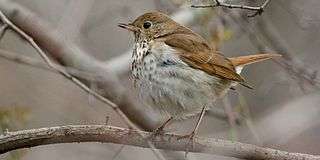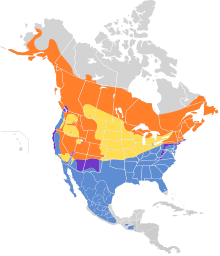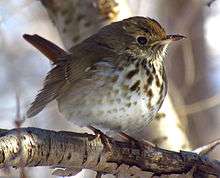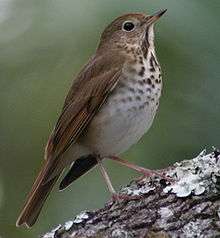Hermit thrush
The hermit thrush (Catharus guttatus) is a medium-sized North American thrush. It is not very closely related to the other North American migrant species of Catharus, but rather to the Mexican russet nightingale-thrush.[2]
| Hermit thrush | |
|---|---|
 | |
| Scientific classification | |
| Kingdom: | Animalia |
| Phylum: | Chordata |
| Class: | Aves |
| Order: | Passeriformes |
| Family: | Turdidae |
| Genus: | Catharus |
| Species: | C. guttatus |
| Binomial name | |
| Catharus guttatus (Pallas, 1811) | |
 | |
| Synonyms | |
|
Hylocichla guttata | |
Description
This species measures 15 to 18 cm (5.9 to 7.1 in) in length, spans 25 to 30 cm (9.8 to 11.8 in) across the wings and weighs 18 to 37 g (0.63 to 1.31 oz). Among standard measurements, the wing chord is 7.8 to 11.1 cm (3.1 to 4.4 in), the bill is 1.6 to 1.9 cm (0.63 to 0.75 in) and the tarsus is 2.7 to 3.3 cm (1.1 to 1.3 in). It is more compact and stockier than other North American Catharus thrushes, with relatively longer wings.[4] The hermit thrush has the white-dark-white underwing pattern characteristic of Catharus thrushes. Adults are mainly brown on the upperparts, with reddish tails. The underparts are white with dark spots on the breast and grey or brownish flanks. They have pink legs and a white eye ring. Birds in the east are more olive-brown on the upperparts; western birds are more grey-brown.
Behaviour

Hermit thrushes breed in coniferous or mixed woods across Canada, southern Alaska, and the northeastern and western United States. They make a cup nest on the ground or relatively low in a tree.
While most hermit thrushes migrate to wintering grounds in the southern United States and south to Central America, some remain in northern coastal US states and southern Ontario.[5] They usually breed in forests, but will sometimes winter in parks and wooded suburban neighbourhoods. They are very rare vagrants to western Europe and northeast Asia.[6]
They forage on the forest floor, also in trees or shrubs, mainly eating insects and berries.
Song
The hermit thrush's song[7] has been described as "the finest sound in nature"[8] and is ethereal and flute-like, consisting of a beginning note, then several descending musical phrases in a minor key, repeated at different pitches. It often sings from a high open location. Analysis of the notes of its song indicates that they are related by harmonic simple integer pitch ratios, like many kinds of human music and unlike the songs of other birds that have been similarly examined.[8][9]
In culture

The hermit thrush is the state bird of Vermont.
Walt Whitman construes the hermit thrush as a symbol of the American voice, poetic and otherwise, in his elegy for Abraham Lincoln, "When Lilacs Last in the Dooryard Bloom'd,"[10] one of the fundamental texts in the American literary canon. "A Hermit Thrush"[11] is the name of a poem by the American poet Amy Clampitt. A hermit thrush appears in the fifth section ("What the Thunder Said") of the T. S. Eliot poem The Waste Land.
Former Canadian indie-rock band Thrush Hermit took their name from a reversal of the bird's name. It is also shared by the American bands Hermit Thrushes and Hermit Thrush.
References
- BirdLife International (2012). "Catharus guttatus". IUCN Red List of Threatened Species. 2012. Retrieved 26 November 2013.CS1 maint: ref=harv (link)
- Winker & Pruett, 2006
- Jobling, James A (2010). The Helm Dictionary of Scientific Bird Names. London: Christopher Helm. pp. 111. ISBN 978-1-4081-2501-4.
- Thrushes by Peter Clement. Princeton University Press (2001). ISBN 978-0691088525
- Hermit Thrush, All about Birds
- Brazil, Mark (2009) Birds of East Asia ISBN 978-0-7136-7040-0 page 402
- "Hermit Thrush Song". Archived from the original (WAV) on 2007-10-31. Retrieved 2008-07-26. (Through The Internet Archive)
- Brahic, C. (2014-11-04). "Thrush's song fits human musical scales". New Scientist. Archived from the original on 2014-11-05. Retrieved 2014-11-04.
- Doolittle, E.L.; Gingras, B.; Endres, D.M.; Fitch, W.T. (2014-11-03). "Overtone-based pitch selection in hermit thrush song: Unexpected convergence with scale construction in human music". Proceedings of the National Academy of Sciences. 111: 16616–16621. doi:10.1073/pnas.1406023111. PMC 4246323. PMID 25368163.
- Whitman, Walt. "When Lilacs Last in the Door-yard Bloom'd". Bartleby. Retrieved 2008-07-26.
- Clampitt, Amy. "A Hermit Thrush". The Academy of American Poets. Archived from the original on 2008-05-09. Retrieved 2008-07-26.
Works cited
- Winker, Kevin & Pruett, Christin L. (2006): "Seasonal migration, speciation, and morphological convergence in the avian genus Catharus (Turdidae)." Auk 123(4): 1052–1068. DOI: 10.1642/0004-8038(2006)123[1052:SMSAMC]2.0.CO;2
External links
| Wikimedia Commons has media related to Hermit thrush. |
| Wikispecies has information related to Catharus guttatus |
- Hermit thrush - Catharus guttarus - USGS Patuxent Bird Identification InfoCenter
- Hermit thrush species account - Cornell Lab of Ornithology
- "Hermit thrush media". Internet Bird Collection.
- Hermit thrush photo gallery at VIREO (Drexel University)
- Interactive range map of Catharus guttatus at IUCN Red List maps
